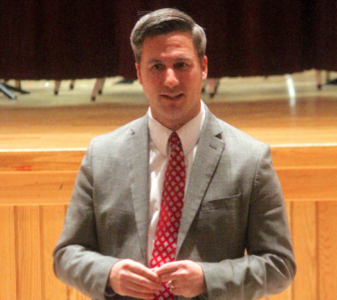Photo: An outdoor automated external defibrillator located at Westerly (RI) High School’s turf field.
June Howell automated external defibrillator
“I knew they can save lives with very little training,” said Belmont’s Recreation Department’s Program Supervisor who said the town had purchased one to be located at the Underwood Pool during the summer and the Skip Viglirolo Skating Rink for the rest of the year.
But the idea of bringing the equipment to the wider community took a back seat due to the cost and logistics associated in keeping the machines need to stay within a specific temperature range.
It took a tragedy on one of the Rec Department’s fields to renew Howell’s commitment to increase the number of AEDs In May, during the first adult softball game played on the diamond across Concord Avenue from the Belmont Public Library, a player in his early 40s suddenly fell to the ground stricken by a heart attack. Before help could arrive, he had died.
“It was terrible,” said Howell who still shakes her head remembering the incident.
Unfortunately, the likelihood of a person dying from a cardiac event like the one that occurred in Belmont is staggeringly high. Each year in the U.S., according to the American Heart Association, there are approximately 360,000 Emergency Medical Services (EMS)-assessed cardiac arrests outside of a hospital setting and on average, less than eight percent of victims survive.
But that does not need to the case if an AED is close at hand. The New England Journal of Medicine reported communities with comprehensive AED programs that include cardiopulmonary resuscitation (CPR) and AED training of the public have achieved survival rates of nearly 40 percent for cardiac arrest victims.
According to Howell, who told the story at Belmont Recreation Commission meeting on Monday, Dec. 3, “it’s time provide greater safety to the community.”
As a result of the incident and the Rec Department’s efforts, Belmont is moving to become the first municipality in Massachusetts and one of the few in the entire US to install AEDs at its town-owned fields and playgrounds that can be used by citizens.
Howell said Belmont will copy a program in Westerly, Rhode Island, that has been up and running for nearly a decade. The seaside community currently has seven outside locations including the high school turf field and at the town’s beach.
Westerly, along with Warwick, have been designated HeartSafe communities, part of a long-running program underwritten by Rhode Island’s Department of Health. With an emphasis on quickly meeting the need of those in cardiac arrest, Westerly has installed more than 100 automated external defibrillators throughout town in public buildings, at schools and in its police vehicles while providing extensive public training in using AEDs.
Like Westerly, Belmont’s defibrillators will be stored in climate controlled enclosures which enables them to be accessible on a 24/7 basis throughout all seasons. When the defibrillator is needed, a person calls 911 and Belmont dispatchers will provide an access code to open the storage compartment, enabling retrieval and use of the AED. Using an AED is “nearly foolproof,” said commission member and physician’s assistant Kathryn Jones, who enthusiastically supported the proposal.
The first Belmont AEDs will be placed at five town-owned fields:
- Pequossette (PQ) Park,
- Grove Street Playground,
- Payson Park,
- Winn Brook Playground, and
- Town Field.
The Recreation Division is currently meeting with the Belmont Fire Department and Belmont Light on the best sites for the equipment to be stationed and in bringing power to the posts where the AEDs will be located. It is also getting a quote from Zoll Medical, the town’s AED supplier, for the cost of additional equipment as well as maintaining and inspecting the devices once installed.
The Rec Department approached seven groups to assist in funding the venture and Belmont Soccer indicated it would fund the first $10,000 with Belmont Youth Baseball ready to step up to the plate. Howell said she’s looking for additional private funding to pay for the infrastructure work and possible town-wide training on using the equipment.
Those who wish to donate can contact Howell at 617-993-2760 or email at:
https://www.belmont-ma.gov/users/jhowell/contact
While the town fields and playgrounds are crowded with youth and soon high school sports teams and activities, Howell said she sees the AEDs as “not specifically for kids but for every resident.”
“It’s amazing,” said Howell on how using a defibrillator increases the survivability of a person suffering a heart attack.
“It really will save a life.”







